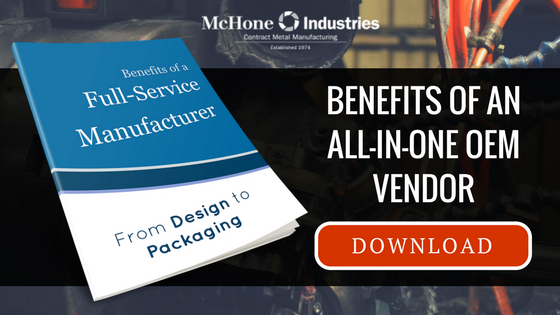 You should always approach choosing a metal based on which properties matter most for your project. Say you need a metal that’s easy to cut by machine, but can also be welded super-smoothly.
You should always approach choosing a metal based on which properties matter most for your project. Say you need a metal that’s easy to cut by machine, but can also be welded super-smoothly.
Which do you pick? None, because there’s no such thing!
Here’s why machinability vs. weldability is a battle you want to avoid.
Machinability Vs. Weldability: Definitions
Metal differs in several key categories. Two of the most important distinctions are machinability vs. weldability.
Machinability
This term, also called “free machining,” is the ability to cut a metal with a blade. It does not refer to the ability to laser cut.
Your vendor can cut machinable metals at high speeds and with less expensive tools. An easier process is a cheaper one with less lead time for you.
For someone ordering in low volume, the difference in a metal’s machinability is less of a factor than for someone buying thousands of parts.
Weldability
You guessed it: Weldability is the ease of welding a material. Weldable materials require less prep time (again, meaning lower production costs and lead time for you) and less expertise from the welder. Less desirable materials require more advanced welding techniques and, sometimes, additional considerations like preheating.
The material’s chemical composition determines its weldability. High-carbon steels, for example, are less weldable due to their poor ductility.
Machinability Vs. Weldability by Materials
 “Poor” is a relative term and doesn’t mean a metal is impossible to work with. For example, most grades of stainless steel can be machined, just keep in mind that stainless is vulnerable to work hardening.
“Poor” is a relative term and doesn’t mean a metal is impossible to work with. For example, most grades of stainless steel can be machined, just keep in mind that stainless is vulnerable to work hardening.
(Click here for a more in-depth look at the machinability of stainless steel.)
There are numerous grades of each metal, so don’t blindly select a metal without studying which grade is ideal for your welding or cutting project. Click here for a chart of stainless steel grades, and click here for a chart of carbon steel grades. The charts call out several grades for poor or great machinability or weldability.
To sum it up:
- If your component will require a lot of welds, carbon steel will be the easiest to manipulate. Carbon steel’s already a bit ugly, so you’re probably not worried about making your part look like Frankenstein anyway.
- If it’s imperative your metal can be cut by blade, aluminum is your best choice. It’s soft and less expensive than stainless to replace if you vendor messes up.
Not Sure? Ask an Expert
Wiser material choice means better control over the final outcome, and that’s a good thing for any manufacturing process, be it machining or welding. Choosing the right metal is, too. Work with an all-inclusive vendor who’s experienced in calculating whether higher-end materials are worth the cost for your specific application.


